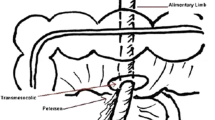Abstract
Introduction
Acute abdominal complaints are a frequent cause for consultation in the emergency department, with a large differential diagnosis. One cause is arcuate line herniation, but this entity is little known and rarely considered during initial analysis. The incidence of arcuate line herniation in this population is unknown.
Methods
A retrospective cohort study was performed. All patients who presented to the emergency department for surgical consultation during an 18-month period with abdominal complaints in who no diagnosis was found after analysis, and who had computed tomography imaging of the abdomen were included. CT scans were reviewed with a focus on abdominal wall pathology and correlated with clinical features.
Results
Eight hundred and ten patients presented with abdominal complaints, 415 of these had CT scans available for review and were included in the study. In 47 patients (11.3%), an arcuate line anomaly was found, and in 14 patients (3.4%), a frank arcuate line herniation (grades 2 or 3) was found. Retrospective correlation with clinical complaints was found in 50% of these patients. Patients with arcuate line hernia had a significantly higher BMI, and diabetes mellitus and aortic aneurysm were more prevalent in these patients.
Conclusion
Arcuate line herniation has a higher incidence than previously thought in patients with acute abdominal complaints and should be considered when evaluating these patients.

Similar content being viewed by others
References
Centraal Bureau voor Statistiek (2016) SEH contacten gebaseerd op het DIS, 2012. Centraal Bureau voor Statistiek. https://www.cbs.nl/nl-nl/maatwerk/2016/26/seh-contacten-gebaseerd-op-het-dis-2012-. Accessed 13 Mar 2019
Montgomery A, Petersson U, Austrums E (2013) The arcuate line hernia: operative treatment and a review of the literature. Hernia 17:391–396
Cappeliez O, Duez V, Alle JL, Leclercq F (2003) Bilateral arcuate-line hernia. Am J Roentgenol 180:864–865
Von Meyenfeldt EM, Van Keulen EM, Eerenberg JP, Hendriks ER (2010) The linea arcuata hernia: a report of two cases. Hernia 14:207–209
Abasbassi M, Hendrickx T, Caluwé G, Cheyns P (2011) Symptomatic linea arcuata hernia. Hernia 15:229–231
Coulier B (2019) Bilateral arcuate line hernia featuring the “ladybug’s elytra” sign. Diagn Interv Imaging 100:387–388
Messaoudi N, Amajoud Z, Mahieu G, Bestman R, Pauli S, Van CM (2014) Laparoscopic arcuate line hernia repair. Surg Laparosc Endosc Percutaneous Tech 24:e110–e112
Siddique K, Slaven K, Samad A (2013) Anterior abdominal wall “peritoneal recess”: cause for pseudoherniation of small bowel resulting in chronic abdominal pain. Ann R Coll Surg Engl 95:e47–e49
Coulier B (2007) Multidetector computed tomography features of linea arcuata (arcuate-line of Douglas) and linea arcuata hernias. Surg Radiol Anat 29:397–403
Pans A, Pierard GE, Albert A (1999) Immunohistochemical study of the rectus sheath and transversalis fascia in adult groin hernias. Hernia 3:45–51
Monkhouse WS, Khalique A (1986) Variations in the composition of the human rectus sheath: a study of the anterior abdominal wall. J Anat 145:61–66
Rizk NN (1991) The arcuate line of the rectus sheath—does it exist? J Anat 175:1–6
Cunningham SC, Rosson GD, Lee RH, Williams JZ, Lustman CA, Slezak S et al (2004) Localization of the arcuate line from surface anatomic landmarks: a cadaveric study. Ann Plast Surg 53:129–131
Loukas M, Myers C, Shah R, Tubbs RS, Wartmann C, Apaydin N et al (2008) Arcuate line of the rectus sheath: clinical approach. Anat Sci Int 83:140–144
Mwachaka PM, Saidi HS, Odula PO, Awori KO, Kaisha WO (2010) Locating the arcuate line of Douglas: is it of surgical relevance? Clin Anat 23:84–86
Scheltinga MR, Roumen RM (2018) Anterior cutaneous nerve entrapment syndrome (ACNES). Hernia 22:507–516
Funding
None.
Author information
Authors and Affiliations
Contributions
The authors declare that they equally contributed to the conception and design of the study, its implementation, and the preparation and revisions of the resulting manuscript.
Corresponding author
Ethics declarations
Conflict of interest
No conflicts of interest are declared by the authors.
Ethical approval
This study was registered and approved by the VieCuri Medical Centre scientific committee. Due to the nature of the study, no formal review and approval by a ethical review board was needed.
Statement of human and animal rights
This study does not contain any studies with animals performed by any of the authors.
Informed consent
For this type of study, no formal informed consent was necessary.
Additional information
Publisher's Note
Springer Nature remains neutral with regard to jurisdictional claims in published maps and institutional affiliations.
Rights and permissions
About this article
Cite this article
Bloemen, A., Kranendonk, J., Sassen, S. et al. Incidence of arcuate line hernia in patients with abdominal complaints: radiological and clinical features. Hernia 23, 1199–1203 (2019). https://doi.org/10.1007/s10029-019-02067-8
Received:
Accepted:
Published:
Issue Date:
DOI: https://doi.org/10.1007/s10029-019-02067-8




